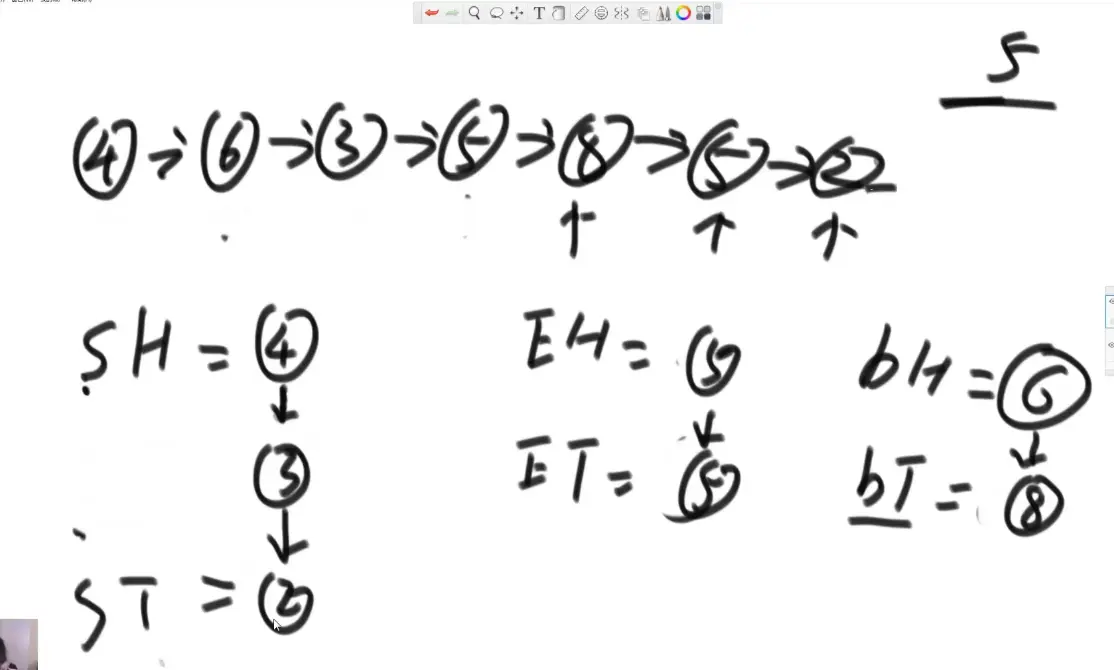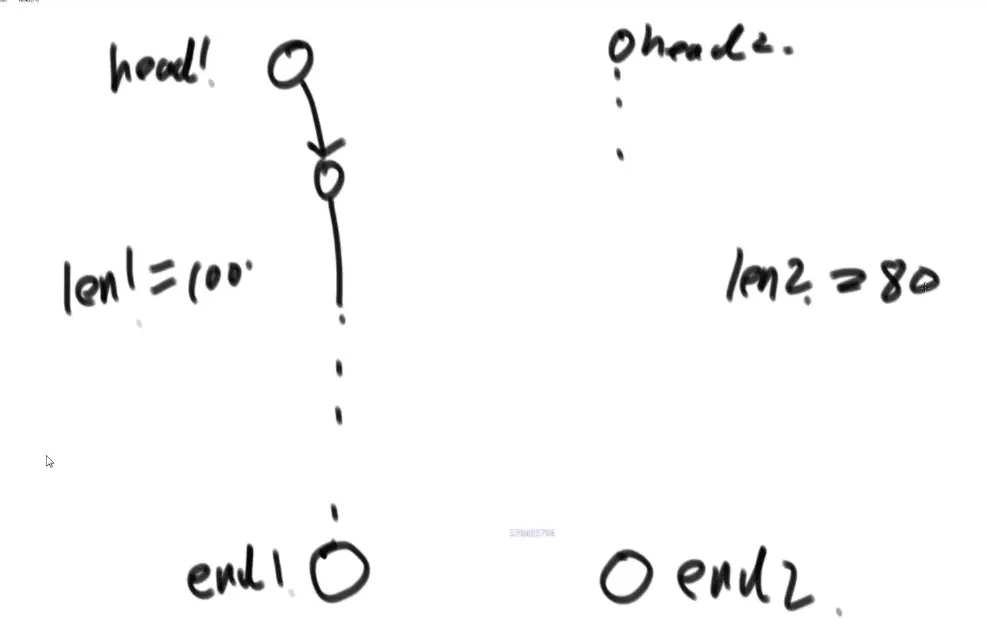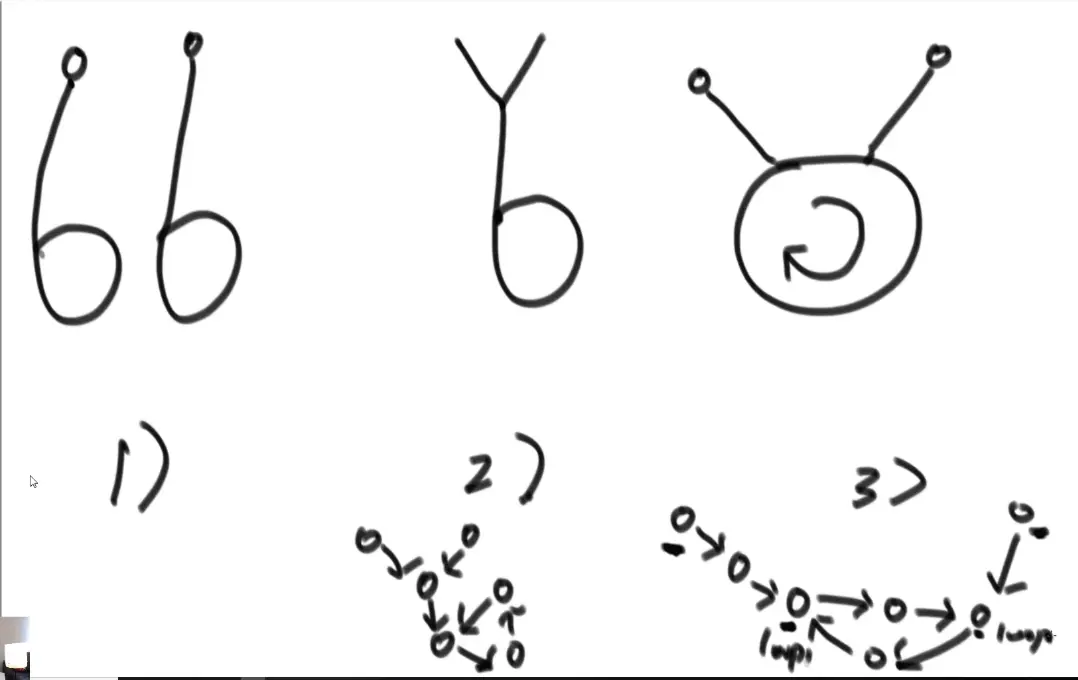链表
链表
哈希表
1)哈希表在使用层面上可以理解为一种集合结构 2)如果只有key,没有伴随数据value,可以使用HashSet结构(C++中叫UnOrderedSet) 3)如果既有key,又有伴随数据value,可以使用HashMap结构(C++中叫UnOrderedMap) 4)有无伴随数据,是HashMap和HashSet唯一的区别,底层的实际结构是一回事 5)使用哈希表增(put)、删(remove)、改(put)和查(get)的操作,可以认为时间复杂度为 O(1),但是常数时间比较大 6)放入哈希表的东西,如果是基础类型,内部按值传递,内存占用就是这个东西的大小 7)放入哈希表的东西,如果不是基础类型,内部按引用传递,内存占用是这个东西内存地 址的大小
有序表
1)有序表在使用层面上可以理解为一种集合结构 2)如果只有key,没有伴随数据value,可以使用TreeSet结构(C++中叫OrderedSet) 3)如果既有key,又有伴随数据value,可以使用TreeMap结构(C++中叫OrderedMap) 4)有无伴随数据,是TreeSet和TreeMap唯一的区别,底层的实际结构是一回事 5)有序表和哈希表的区别是,有序表把key按照顺序组织起来,而哈希表完全不组织 5)红黑树、AVL树、size-balance-tree和跳表等都属于有序表结构,只是底层具体实现 不同 6)放入哈希表的东西,如果是基础类型,内部按值传递,内存占用就是这个东西的大小 7)放入哈希表的东西,如果不是基础类型,必须提供比较器,内部按引用传递,内存占用是这个东西内存地址的大小 8)不管是什么底层具体实现,只要是有序表,都有以下固定的基本功能和固定的时间复杂度
有序表的固定操作
1)void put(K key, V value):将一个(key,value)记录加入到表中,或者将key的记录 更新成value。
2)V get(K key):根据给定的key,查询value并返回。
3)void remove(K key):移除key的记录。
4)boolean containsKey(K key):询问是否有关于key的记录。
5)K firstKey():返回所有键值的排序结果中,最左(最小)的那个。
6)K lastKey():返回所有键值的排序结果中,最右(最大)的那个。
7)K floorKey(K key):如果表中存入过key,返回key;否则返回所有键值的排序结果中, key的前一个。
8)K ceilingKey(K key):如果表中存入过key,返回key;否则返回所有键值的排序结果中, key的后一个。
以上所有操作时间复杂度都是O(logN),N为有序表含有的记录数
TreeSet<Node> treeSet = new TreeSet<>();
// 以下的代码会报错,因为没有提供Node类型的比较器
try {
treeSet.add(nodeA);
treeSet.add(nodeB);
treeSet.add(nodeC);
} catch (Exception e) {
System.out.println("错误信息:" + e.getMessage());
}
treeSet = new TreeSet<>(new NodeComparator());
// 以下的代码没问题,因为提供了Node类型的比较器
try {
treeSet.add(nodeA);
treeSet.add(nodeB);
treeSet.add(nodeC);
System.out.println("这次节点都加入了");
} catch (Exception e) {
System.out.println(e.getMessage());
}
System.out.println("========5=========");
// 展示有序表常用操作
TreeMap<Integer, String> treeMap1 = new TreeMap<>();
treeMap1.put(7, "我是7");
treeMap1.put(5, "我是5");
treeMap1.put(4, "我是4");
treeMap1.put(3, "我是3");
treeMap1.put(9, "我是9");
treeMap1.put(2, "我是2");
System.out.println(treeMap1.containsKey(5));
System.out.println(treeMap1.get(5));
System.out.println(treeMap1.firstKey() + ", 我最小");
System.out.println(treeMap1.lastKey() + ", 我最大");
System.out.println(treeMap1.floorKey(8) + ", 在表中所有<=8的数中,我离8最近");
System.out.println(treeMap1.ceilingKey(8) + ", 在表中所有>=8的数中,我离8最近");
System.out.println(treeMap1.floorKey(7) + ", 在表中所有<=7的数中,我离7最近");
System.out.println(treeMap1.ceilingKey(7) + ", 在表中所有>=7的数中,我离7最近");
treeMap1.remove(5);
System.out.println(treeMap1.get(5) + ", 删了就没有了哦");
System.out.println("========6=========");
链表
单链表翻转
public static Node reverseList(Node head) {
Node pre = null;
Node next = null;
while (head != null) {
next = head.next;
head.next = pre;
pre = head;
head = next;
}
return pre;
}
双链表翻转
public static DoubleNode reverseList(DoubleNode head) {
DoubleNode pre = null;
DoubleNode next = null;
while (head != null) {
next = head.next;
head.next = pre;
head.last = next;
pre = head;
head = next;
}
return pre;
}
打印两个单链表的公共部分
【题目】 给定两个有序链表的头指针head1和head2,打印两个链表的公共部分。 【要求】 如果两个链表的长度之和为N,时间复杂度要求为O(N),额外空间复 杂度要求为O(1)
public static void printCommonPart(Node head1, Node head2) {
System.out.print("Common Part: ");
while (head1 != null && head2 != null) {
if (head1.value < head2.value) {
head1 = head1.next;
} else if (head1.value > head2.value) {
head2 = head2.next;
} else {
System.out.print(head1.value + " ");
head1 = head1.next;
head2 = head2.next;
}
}
System.out.println();
}
链表解题的方法论
1)对于笔试,不用太在乎空间复杂度,一切为了时间复杂度 2)对于面试,时间复杂度依然放在第一位,但是一定要找到空间最省的方法
重要技巧: 1)额外数据结构记录(哈希表等) 2)快慢指针
判断一个链表是否为回文结构
【题目】给定一个单链表的头节点head,请判断该链表是否为回文结构。 【例子】1->2->1,返回true; 1->2->2->1,返回true;15->6->15,返回true; 1->2->3,返回false。 【例子】如果链表长度为N,时间复杂度达到O(N),额外空间复杂度达到O(1)。
笔试
- 栈
// need n extra space
public static boolean isPalindrome1(Node head) {
Stack<Node> stack = new Stack<Node>();
Node cur = head;
while (cur != null) {
stack.push(cur);
cur = cur.next;
}
while (head != null) {
if (head.value != stack.pop().value) {
return false;
}
head = head.next;
}
return true;
- 快慢指针+栈 快慢指针需要将各种不同小情况写熟练
// need n/2 extra space
public static boolean isPalindrome2(Node head) {
if (head == null || head.next == null) {
return true;
}
Node right = head.next;
Node cur = head;
while (cur.next != null && cur.next.next != null) {
right = right.next;
cur = cur.next.next;
}
Stack<Node> stack = new Stack<Node>();
while (right != null) {
stack.push(right);
right = right.next;
}
while (!stack.isEmpty()) {
if (head.value != stack.pop().value) {
return false;
}
head = head.next;
}
return true;
}
- O(1)
// need O(1) extra space
public static boolean isPalindrome3(Node head) {
if (head == null || head.next == null) {
return true;
}
Node n1 = head;
Node n2 = head;
while (n2.next != null && n2.next.next != null) { // find mid node
n1 = n1.next; // n1 -> mid
n2 = n2.next.next; // n2 -> end
}
n2 = n1.next; // n2 -> right part first node
n1.next = null; // mid.next -> null
Node n3 = null;
while (n2 != null) { // right part convert
n3 = n2.next; // n3 -> save next node
n2.next = n1; // next of right node convert
n1 = n2; // n1 move
n2 = n3; // n2 move
}
n3 = n1; // n3 -> save last node
n2 = head;// n2 -> left first node
boolean res = true;
while (n1 != null && n2 != null) { // check palindrome
if (n1.value != n2.value) {
res = false;
break;
}
n1 = n1.next; // left to mid
n2 = n2.next; // right to mid
}
n1 = n3.next;
n3.next = null;
while (n1 != null) { // recover list
n2 = n1.next;
n1.next = n3;
n3 = n1;
n1 = n2;
}
return res;
}
https://www.bilibili.com/video/BV13g41157hK?p=5&t=5602.4
将单向链表按某值划分成左边小中间相等右边大的形式
【题目】给定一个单链表的头节点head,节点的值类型是整型,再给定一个整 数pivot。实现一个调整链表的函数,将链表调整为左部分都是值小于pivot的 节点,中间部分都是值等于pivot的节点,右部分都是值大于pivot的节点。
public static Node listPartition1(Node head, int pivot) {
if (head == null) {
return head;
}
Node cur = head;
int i = 0;
while (cur != null) {
i++;
cur = cur.next;
}
Node[] nodeArr = new Node[i];
i = 0;
cur = head;
for (i = 0; i != nodeArr.length; i++) {
nodeArr[i] = cur;
cur = cur.next;
}
arrPartition(nodeArr, pivot);
for (i = 1; i != nodeArr.length; i++) {
nodeArr[i - 1].next = nodeArr[i];
}
nodeArr[i - 1].next = null;
return nodeArr[0];
}
public static void arrPartition(Node[] nodeArr, int pivot) {
int small = -1;
int big = nodeArr.length;
int index = 0;
while (index != big) {
if (nodeArr[index].value < pivot) {
swap(nodeArr, ++small, index++);
} else if (nodeArr[index].value == pivot) {
index++;
} else {
swap(nodeArr, --big, index);
}
}
}
【进阶】在实现原问题功能的基础上增加如下的要求 【要求】调整后所有小于pivot的节点之间的相对顺序和调整前一样 【要求】调整后所有等于pivot的节点之间的相对顺序和调整前一样 【要求】调整后所有大于pivot的节点之间的相对顺序和调整前一样 【要求】时间复杂度请达到O(N),额外空间复杂度请达到O(1)。
public static Node listPartition2(Node head, int pivot) {
Node sH = null; // small head
Node sT = null; // small tail
Node eH = null; // equal head
Node eT = null; // equal tail
Node bH = null; // big head
Node bT = null; // big tail
Node next = null; // save next node
// every node distributed to three lists
while (head != null) {
next = head.next;
head.next = null;
if (head.value < pivot) {
if (sH == null) {
sH = head;
sT = head;
} else {
sT.next = head;
sT = head;
}
} else if (head.value == pivot) {
if (eH == null) {
eH = head;
eT = head;
} else {
eT.next = head;
eT = head;
}
} else {
if (bH == null) {
bH = head;
bT = head;
} else {
bT.next = head;
bT = head;
}
}
head = next;
}
// small and equal reconnect
if (sT != null) {
sT.next = eH;
eT = eT == null ? sT : eT;
}
// all reconnect
if (eT != null) {
eT.next = bH;
}
return sH != null ? sH : eH != null ? eH : bH;
}
public static void arrPartition(Node[] nodeArr, int pivot) {
int small = -1;
int big = nodeArr.length;
int index = 0;
while (index != big) {
if (nodeArr[index].value < pivot) {
swap(nodeArr, ++small, index++);
} else if (nodeArr[index].value == pivot) {
index++;
} else {
swap(nodeArr, --big, index);
}
}
}
笔试
放数组里快排
面试


注意
最后相连的时候考虑清楚边界,防止某块范围空指针
复制含有随机指针节点的链表 LeetCode139
【题目】一种特殊的单链表节点类描述如下 class Node { int value; Node next; Node rand; Node(int val) { value = val; } } rand指针是单链表节点结构中新增的指针,rand可能指向链表中的任意一个节点,也可能指向null。给定一个由Node节点类型组成的无环单链表的头节点 head,请实现一个函数完成这个链表的复制,并返回复制的新链表的头节点。
【要求】时间复杂度O(N),额外空间复杂度O(1)
笔试:哈希表
key:老节点,value 新copy的节点
public static Node copyListWithRand1(Node head) {
HashMap<Node, Node> map = new HashMap<Node, Node>();
Node cur = head;
while (cur != null) {
map.put(cur, new Node(cur.value));
cur = cur.next;
}
cur = head;
while (cur != null) {
map.get(cur).next = map.get(cur.next);
map.get(cur).rand = map.get(cur.rand);
cur = cur.next;
}
return map.get(head);
}
面试:利用原链表

然后一对一对处理

public static Node copyListWithRand2(Node head) {
if (head == null) {
return null;
}
Node cur = head;
Node next = null;
// copy node and link to every node
while (cur != null) {
next = cur.next;
cur.next = new Node(cur.value);
cur.next.next = next;
cur = next;
}
cur = head;
Node curCopy = null;
// set copy node rand
while (cur != null) {
next = cur.next.next;
curCopy = cur.next;
curCopy.rand = cur.rand != null ? cur.rand.next : null;
cur = next;
}
Node res = head.next;
cur = head;
// split
while (cur != null) {
next = cur.next.next;
curCopy = cur.next;
cur.next = next;
curCopy.next = next != null ? next.next : null;
cur = next;
}
return res;
}
两个单链表相交的一系列问题
【题目】给定两个可能有环也可能无环的单链表,头节点head1和head2。请实 现一个函数,如果两个链表相交,请返回相交的 第一个节点。如果不相交,返 回null 【要求】如果两个链表长度之和为N,时间复杂度请达到O(N),额外空间复杂度 请达到O(1)。
判断有无环并返回入环节点
- 哈希表 遍历一个放一个 重复则有环
- 快慢指针 相遇后快指针以慢指针的速度从头部走,慢指针继续在环里走,再次相遇就是入环点
public static Node getLoopNode(Node head) {
if (head == null || head.next == null || head.next.next == null) {
return null;
}
Node n1 = head.next; // n1 -> slow
Node n2 = head.next.next; // n2 -> fast
while (n1 != n2) {
if (n2.next == null || n2.next.next == null) {
return null;
}
n2 = n2.next.next;
n1 = n1.next;
}
n2 = head; // n2 -> walk again from head
while (n1 != n2) {
n1 = n1.next;
n2 = n2.next;
}
return n1;
}
如果无环
分别loop判断两个链表有没有环
如果两个都无环,相交及往后都共有

如果end1 == end2说明相交 然后求相交节点:从头开始,链表1长100,链表2长80,所以链表1先走20步,然后他们一定会在相交节点相遇
public static Node noLoop(Node head1, Node head2) {
if (head1 == null || head2 == null) {
return null;
}
Node cur1 = head1;
Node cur2 = head2;
int n = 0;
while (cur1.next != null) {
n++;
cur1 = cur1.next;
}
while (cur2.next != null) {
n--;
cur2 = cur2.next;
}
if (cur1 != cur2) {
return null;
}
cur1 = n > 0 ? head1 : head2;
cur2 = cur1 == head1 ? head2 : head1;
n = Math.abs(n);
while (n != 0) {
n--;
cur1 = cur1.next;
}
while (cur1 != cur2) {
cur1 = cur1.next;
cur2 = cur2.next;
}
return cur1;
}
如果有环

- 情况2:用无环的时候处理方法,长的先走,最后相交
- 情况1:loop1继续往下走,如果能遇到loop2说明是情况3 如果情况1,相交节点为null 情况3,返回随便一个入环节点
code
首先判断两个链表是否有环并拿到入环节点
public static Node getIntersectNode(Node head1, Node head2) {
if (head1 == null || head2 == null) {
return null;
}
Node loop1 = getLoopNode(head1);
Node loop2 = getLoopNode(head2);
if (loop1 == null && loop2 == null) {
return noLoop(head1, head2);
}
if (loop1 != null && loop2 != null) {
return bothLoop(head1, loop1, head2, loop2);
}
return null;
}
public static Node bothLoop(Node head1, Node loop1, Node head2, Node loop2) {
Node cur1 = null;
Node cur2 = null;
if (loop1 == loop2) {
cur1 = head1;
cur2 = head2;
int n = 0;
while (cur1 != loop1) {
n++;
cur1 = cur1.next;
}
while (cur2 != loop2) {
n--;
cur2 = cur2.next;
}
cur1 = n > 0 ? head1 : head2;
cur2 = cur1 == head1 ? head2 : head1;
n = Math.abs(n);
while (n != 0) {
n--;
cur1 = cur1.next;
}
while (cur1 != cur2) {
cur1 = cur1.next;
cur2 = cur2.next;
}
return cur1;
} else {
cur1 = loop1.next;
while (cur1 != loop1) {
if (cur1 == loop2) {
return loop1;
}
cur1 = cur1.next;
}
return null;
}
}



